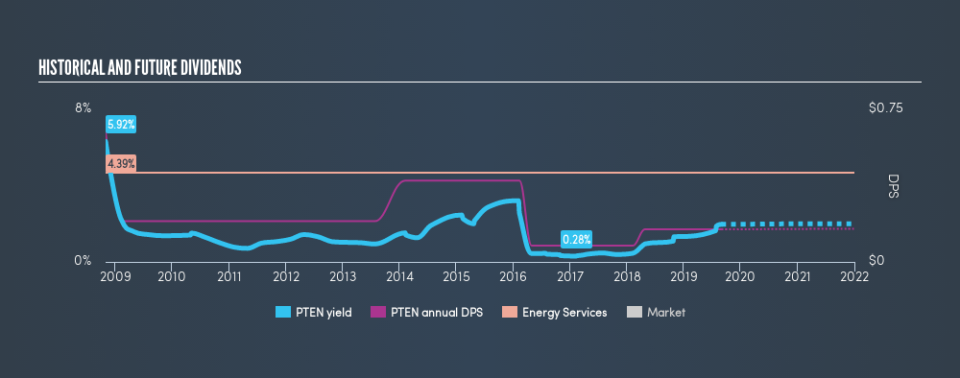We Wouldn't Be Too Quick To Buy Patterson-UTI Energy, Inc. (NASDAQ:PTEN) Before It Goes Ex-Dividend

Patterson-UTI Energy, Inc. (NASDAQ:PTEN) is about to trade ex-dividend in the next 3 days. Investors can purchase shares before the 4th of September in order to be eligible for this dividend, which will be paid on the 19th of September.
Patterson-UTI Energy's next dividend payment will be US$0.04 per share, and in the last 12 months, the company paid a total of US$0.16 per share. Last year's total dividend payments show that Patterson-UTI Energy has a trailing yield of 1.8% on the current share price of $8.65. If you buy this business for its dividend, you should have an idea of whether Patterson-UTI Energy's dividend is reliable and sustainable. As a result, readers should always check whether Patterson-UTI Energy has been able to grow its dividends, or if the dividend might be cut.
See our latest analysis for Patterson-UTI Energy
Dividends are usually paid out of company profits, so if a company pays out more than it earned then its dividend is usually at greater risk of being cut. Patterson-UTI Energy reported a loss after tax last year, which means it's paying a dividend despite being unprofitable. While this might be a one-off event, this is unlikely to be sustainable in the long term. Considering the lack of profitability, we also need to check if the company generated enough cash flow to cover the dividend payment. If Patterson-UTI Energy didn't generate enough cash to pay the dividend, then it must have either paid from cash in the bank or by borrowing money, neither of which is sustainable in the long term. Luckily it paid out just 13% of its free cash flow last year.
Click here to see the company's payout ratio, plus analyst estimates of its future dividends.
Have Earnings And Dividends Been Growing?
Companies with falling earnings are riskier for dividend shareholders. If business enters a downturn and the dividend is cut, the company could see its value fall precipitously. Patterson-UTI Energy was unprofitable last year and, unfortunately, the general trend suggests its earnings have been in decline over the last 5 years, making us wonder if the dividend is sustainable at all.
Many investors will assess a company's dividend performance by evaluating how much the dividend payments have changed over time. Patterson-UTI Energy's dividend payments per share have declined at 13% per year on average over the past 10 years, which is uninspiring. While it's not great that earnings and dividends per share have fallen in recent years, we're encouraged by the fact that management has trimmed the dividend rather than risk over-committing the company in a risky attempt to maintain yields to shareholders.
Remember, you can always get a snapshot of Patterson-UTI Energy's financial health, by checking our visualisation of its financial health, here.
Final Takeaway
Has Patterson-UTI Energy got what it takes to maintain its dividend payments? First, it's not great to see the company paying a dividend despite being loss-making over the last year. On the plus side, the dividend was covered by free cash flow. With the way things are shaping up from a dividend perspective, we'd be inclined to steer clear of Patterson-UTI Energy.
Wondering what the future holds for Patterson-UTI Energy? See what the 24 analysts we track are forecasting, with this visualisation of its historical and future estimated earnings and cash flow
We wouldn't recommend just buying the first dividend stock you see, though. Here's a list of interesting dividend stocks with a greater than 2% yield and an upcoming dividend.
We aim to bring you long-term focused research analysis driven by fundamental data. Note that our analysis may not factor in the latest price-sensitive company announcements or qualitative material.
If you spot an error that warrants correction, please contact the editor at editorial-team@simplywallst.com. This article by Simply Wall St is general in nature. It does not constitute a recommendation to buy or sell any stock, and does not take account of your objectives, or your financial situation. Simply Wall St has no position in the stocks mentioned. Thank you for reading.

 Yahoo Finance
Yahoo Finance 
